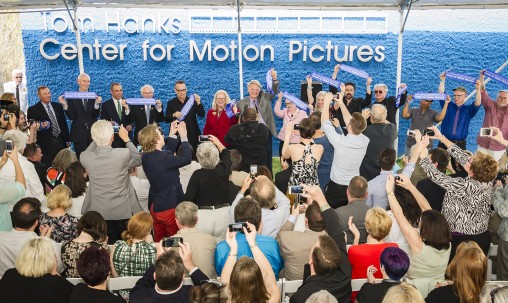
Acclaimed actor, producer and director Tom Hanks helped dedicate the Tom Hanks Center for Motion Pictures at Wright State University during a ceremony April 19. (Photo by Chris Snyder)
It was a moment.
It came in the middle of Hollywood actor and producer Tom Hanks’ two-day visit to Dayton to see historic Wright brothers’ sites, dedicate the Tom Hanks Center for Motion Pictures at Wright State University and celebrate the university’s Rise. Shine. fundraising campaign.
Hanks was being given a tour of the National Museum of the United States Air Force and had just stepped into the Air Force One that carried the body of President John F. Kennedy home from the 1963 assassination in Dallas.
Here is where they removed two rows of seats to get the casket into the cabin, Hanks was told. Here is where Jackie was sitting. Here is where Lyndon Johnson was sworn in.
The plane was thick with world-changing history, a history that had a spectral, ghost-like presence. And Hanks was visibly moved.
“Man oh man,” he exhaled after emerging from the aircraft. “THAT is an important time capsule.”
There were other moments during Hanks’ visit.
He was able to put his hands on the original 1905 Wright Flyer, the world’s first practical airplane. He stood on the historic prairie where the Wright brothers perfected the aircraft. He dazzled hundreds of Wright State performing arts students with a personal sharing of his life and experience. And he charmed a campus with his warmth and humor.
Hanks is the genuine article. His motor never stops running. His creative furnace never stops roaring. He has an infectious enthusiasm. And he doesn’t mail it in. He touches people.
And from the very beginning, there were the jokes — Tom Hanks-size jokes.
Monday, April 18
2:15 p.m.
A sleek white charter plane lands and taxis up to a hangar at Dayton-Wright Brothers Airport in Miami Township. Hanks starts to walk out of the plane and then jokingly turns around as if changing his mind.
When he does emerge, the two-time Academy Award-winning actor, producer and director looks larger than life. Dressed in jeans, a dark sport coat and black square-toed boots, he sports sunglasses and has a travel bag slung over his shoulder. The greeting party includes Wright brothers descendants Amanda Wright Lane and Stephen Wright, Wright State President David R. Hopkins and Stuart McDowell, chair and artistic director of the Wright State Department of Theatre, Dance and Motion Pictures and a longtime friend of Hanks.
Just down the taxiway is the Wright “B” Flyer, a replica of the Wright brothers’ first production airplane — the Model B. Hanks tells his wife, actress and singer Rita Wilson, that her baggage won’t fit on the Flyer, that it will require some bungee cords.
Wilson is actually flying on to Nashville on the charter jet and kisses her husband goodbye.
Hanks walks over to the Wright B Flyer with Hopkins.
“I think you should land it over on campus.”
Volunteers fire up the plane and do a brief takeoff and landing. Hanks takes it all in.
“Do you ever get a groundspeed of nil? You’re just hovering there?”
Hanks walks around and introduces himself to the volunteers — most of them retirees — as “Tom Hanks.”
“Thank you volunteers. Now back to your wives.”
As the entourage leaves the airport gate in a two-vehicle caravan, an autograph seeker with a movie poster stands in the parking lot. Hanks stops and obliges.
3:19 p.m.
The entourage arrives at Hawthorn Hill, the Oakwood mansion of Orville Wright, and pulls into the driveway for a slow-motion drive-by.
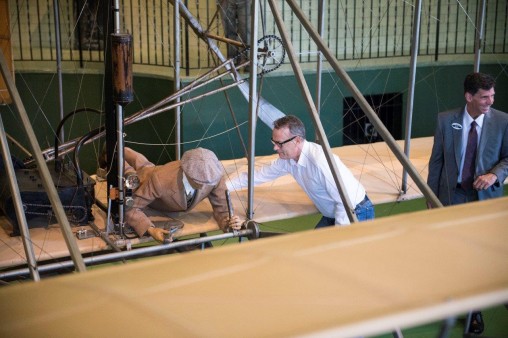
Tom Hanks with the 1905 Wright Flyer III at Carillon Historical Park. At right is Brady Kress ’96, the park’s president and CEO. (Photo by Will Jones)
3:28 p.m.
The entourage arrives at Carillon Historical Park, where it is greeted at the gate by President and CEO Brady Kress ’96, who escorts the vehicles onto the site in a 1911 Model T. Hanks asks Kress to blow the horn and then later gets a lesson on the handcrank starter.
“I thought it would be kind of fun for Tom to see the car and for the production crew to see what kind of assets are in town,” Kress said.
Hanks’ film production company, Playtone, is collaborating with two-time Pulitizer Prize-winning author David McCullough to transform his 2015 New York Times No. 1 bestseller “The Wright Brothers” into an HBO miniseries. Local officials hope some of it will be filmed in the Dayton area.
The entourage enters the Wright Brothers Aviation Center, which houses the original 1905 Wright Flyer III, the world’s first practical airplane. But the first stop is a replica of the Wrights’ bicycle shop.
“I just love the leather belt drives. Boy, you could get your hair caught in a lot of things.”
In another room there is the propeller of the Wright aircraft used in the 1908 flight at LeMans, France, and the sewing machine the Wright brothers used to sew the fabric for the wings.
“And it’s just sitting here? Shouldn’t it be behind some security guards?”
Hanks is then permitted to step down into a pit and inspect the 1905 Wright Flyer. He is told that the Wrights painted the plane’s wooden spars silver to confuse competing inventors trying to copy the design into thinking the spars were metal and would thus design planes too heavy to fly.
“So once again, they were diabolical geniuses. Very smart. That’s brilliant.”
Kress was impressed with his Hanks’ grasp of aviation history.
“Not only did he have a good knowledge of the story to begin with, his follow-up questions were really great,” Kress said. “He was very genuine and very interested.”
4:22 p.m.
The entourage arrives at the Wright Cycle Shop in Wright Dunbar Village. Hanks gets a lesson in the Wrights’ bicycle-building history from a park ranger.
Hanks eyeballs the display of a Draisin highwheel, whose monster-sized front wheel and tiny back wheel would sometimes lead to riders being hurtled over the handlebars.
“This would kill you.”
The autograph seeker who stopped Hanks at the airport was waiting with his son outside the cycle shop when the entourage emerges. Hanks graciously agrees to pose with the boy for photos and jokes with him.
“Don’t drink and drive. Stay in school.”
4:35 p.m.
The entourage arrives at the Wright Company Factory Site. The factory is the birthplace of America’s aerospace industry — the first American factory built for the purpose of manufacturing airplanes. The two structures are the oldest airplane manufacturing buildings still standing in the world and the only buildings still in Dayton where the Wright brothers worked on airplanes. Work is under way to restore and open the buildings to the public. Hanks and his entourage pull up next to the buildings, but don’t go inside.
5 p.m.
Hanks checks in at the Hilton Garden Inn in Beavercreek, where he gets ready for an evening social event.
6:44 p.m.
The Hanks entourage arrives at the Air Force museum for a reception and dinner. The group is dressed up for dinner, with Hanks wearing a blue pinstriped suit.
“It’s like a Mafia funeral.”
In the lobby, Hanks jokes about making a movie in which the plot would be about stealing one of the museum’s planes.
The reception and dinner is held in a hangar right next to Bockscar, the B-29 bomber that dropped a nuclear bomb over the Japanese city of Nagasaki during World War II in the second — and last — nuclear attack in history.
Hanks is very knowledgeable about Bockscar and many of the planes in the museum. He readily shares that information with anyone within earshot.
“This is the stuff that fills my head.”
At Hanks’ table are Lt. Gen. Jack Hudson, museum director; Jack Hampshire, a 90-year-old military veteran and museum volunteer; and five Wright State students who are military veterans.
After dinner, Hanks, who has an extensive private collection of manual typewriters, is shown a display featuring several manual typewriters used by the military over the years. There is also a robins egg blue electric typewriter used by President Kennedy on Air Force One to make changes to speeches.
Arms linked behind his back, Hanks then strolls through the museum with Hudson. They walked past the B-17 Shoo Shoo Baby (“Look at that upper machine-gun turret”), the silver goblets that commemorate the 80 men who flew the Doolittle Raid against Japan in 1942, the balloon gondola from which Joseph Kittinger jumped from a then-record height of more than 102,000 feet (“I think that would have been a blast. Go up as high as you can and then jump out.”) and through Air Force One and the C-141 Hanoi Taxi, which airlifted the first American prisoners of war out of North Vietnam in 1973.
“What a great night. This is what happens when you’re a big honkin’ movie star. They shut down the whole museum for you.”
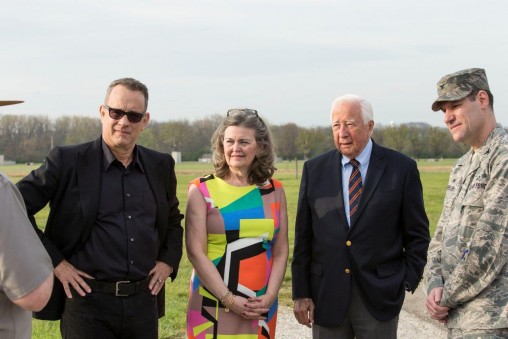
Tom Hanks at Huffman Prairie with, from left, Amanda Wright Lane, David McCullough and Col. John Devillier, commander of Wright-Patterson Air Force Base. (Photo by Will Jones)
Tuesday, April 19
7:55 a.m.
Hanks finishes breakfast in the hotel lobby and prepares to depart for Huffman Prairie, the historic site where the Wright brothers created a dependable, fully controllable airplane and trained themselves to be pilots. Hanks is dressed in a dark suit and black shirt, looking every bit the Robert Langdon character in “The Da Vinci Code” and “Angels and Demons.”
During the ride over, Hanks talks movies.
“Nothing is more fun for everybody at the office than to sit around in pre-production and just talk story,” he said. “It’s people who have read everything and are excited about everything, and we sit around for months and say, ‘What if we do this? What if we try this?’”
Hanks said making a movie is always a “grand adventure.” The movie “Cloud Atlas” was all of that.
“Every day on that movie was a labor of love. We worked hard,” he said. “On our last day — I worked with Halle Berry — we all burst into tears because the movie was over and we didn’t want it to end.”
“A League of Their Own” was filmed in a small Indiana town, with Hanks and his family living in a big house surrounded by lush, green fields.
“My kids swam in a wading pool and we ate Dairy Queen every night. It was a beautiful idyllic summer,” he said. “And if you ask my kids what was the best summer they ever had, they say that time we made ‘A League of Their Own.’”
Shooting movies is fun, added Hanks.
“It’s the biggest secret that we all keep.”
After arriving at Huffman Prairie, Hanks takes in the vista. White flags mark the perimeter of the field where the Wrights flew.
“Look. There’s the tree where Orville crashed. Put a plaque on that tree.”
Hanks talks with Col. John Devillier, commander of nearby Wright-Patterson Air Force Base.
“Do you ever buzz this field sometimes Colonel?”
Hanks then talks with the park rangers about their job, tells them he would have come to Huffman Prairie as a tourist and then has a suggestion.
“I’d bring some cows in, even if they are cardboard cutouts.”
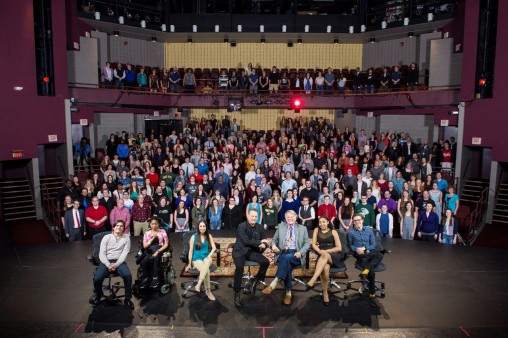
Tom Hanks, center, and W. Stuart McDowell, Theatre, Dance and Motion Pictures department chair, after a “Talk Back” event with with performing arts students in the Festival Playhouse. (Photo by Will Jones)
9 a.m.
Hanks arrives at Wright State and enters a side stage door of the Creative Arts Center. He talks backstage with several students, asking them about their aspirations. One student asked him if he still juggles. (He does.)
Inside the Festival Playhouse are 300 performing arts students eager to see and hear Hanks in a Talk Back session. Hanks is told it will just take a few more seconds to prepare the audience.
“To deal with the hordes, the pandemonium?”
When Hanks is introduced, a roar goes up from the crowd. He takes a chair on stage and sits in a semicircle flanked by McDowell and five students representing all areas of the performing arts program. He is then shown a “This is your life, Tom Hanks” slideshow specially created for the event.
Hanks acknowledges goofing around with standup comedy in the lunchroom at college.
“I didn’t have any real material, but I was a wiseass.”
For the next 90 minutes, Hanks answers questions and throws his heart into it, dazzling the audience with anecdotes and taking them behind the scenes of Hollywood. He’s playful, honest, giving.
“Out of all the jobs in making movies, the one I like to do most is being the star of the movie. It’s a pretty good gig. … At the end of the day, it’s more fun than anything you can possibly imagine.”
Hanks talks about the great art currently being created in film and television, the making of the movie “Cloud Atlas” (“It was mind-bending for all of us”) and how doing theater and movies is totally different, like comparing “apples and skateboards.”
On the making of “Forrest Gump”: Hanks modeled the way he talked in the film after the speech of the Mississippi boy who played the young Forrest. The first scene Hanks filmed in the movie was with actress Robin Wright, and he was so self-conscious that the director threw out the entire day’s shoot.
“Self-consciousness is the death of any sort of creative enterprise.”
Hanks tells the students the importance of challenging themselves.
“I can’t sing. I can’t dance. But the best thing I could have ever done for myself was try to be in a musical and sing and dance. And I did it once or twice, and it scared the children.”
“That was great,” Hanks later tells McDowell. “I really enjoyed that.”
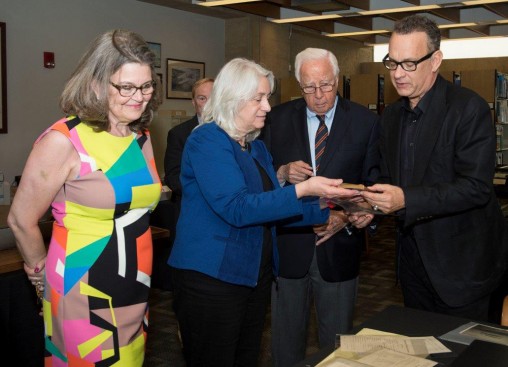
Dawne Dewey, head of Special Collections and Archives at Wright State, showed items from the university’s “Wright Brothers Collection” to David McCullough, Tom Hanks and Amanda Wright Lane. (Photo by Will Jones)
10:45 a.m.
After a walk through the tunnel system, Hanks arrives at Dunbar Library and elevators up to Special Collections and Archives, which houses the largest collection of Wright brothers materials in the world.
“I was intrigued by the tunnels.” “It’s like living in Fritz Lang’s ‘Metropolis.’”
McCullough arrives from across campus, telling Hanks he just gave a “profound lecture.”
“I gave a profane lecture,” Hanks replied.
Along with McCullough, Wright Lane and Dawne Dewey, head of the archives, Hanks goes through a collection of Wright brother photos, sketches, writings, medals and newspaper clippings.
Then the group views rare home movies of Orville Wright. They feature footage of the Wright family vacationing on an island bought by Orville in Georgian Bay, Canada, a Thanksgiving at Hawthorn Hill and children sledding down a hill at the mansion. They also show the 1927 arrival at Wright Field in Dayton of Charles Lindbergh, who made the first solo nonstop flight across the Atlantic. He is seen riding in a car with Orville.
After the movies there is a discussion of historical things, and McCullough mentions that he still writes on a manual typewriter. And he says he marvels at Hanks’ extensive collection of manual typewriters.
“No one throws away a typewritten letter,” Hanks said. “I probably send a letter out — two or three every day. I sent a letter to a kid who wrote to Forrest Gump the other day. So Forrest answered him on the typewriter: ‘My friend Tom Hanks is typing this for me.’”
Noon
Hanks lunches at Dunbar Library with several performing arts students, all of whom have received Tom Hanks scholarships.
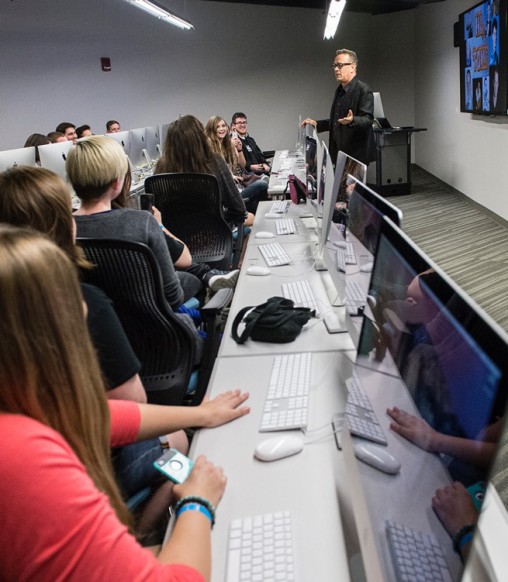
Tom Hanks talking with film students during a tour of the Tom Hanks Center for Motion Pictures. (Photo by Will Jones)
1:15 p.m.
Hanks walks through the tunnels to the New Media Incubator, a partnership between the motion pictures center and the Department of Communication to teach storytelling. He sees a television and recording studio and a “Veterans Voices” project, a series of stories on local veterans’ experiences transitioning to civilian life.
Hanks starred in what some consider the best war movie ever made in “Saving Private Ryan.”
“What a great facility. I could get some work done here myself.”
Then it’s on to the center itself, where Hanks visits four motion pictures classes and takes questions from students.
He encourages students in one class to watch a movie called “The Earrings of Madam de…,” a 1953 French film that follows a pair of earrings as they change hands during a series of betrayals and romances.
“It is the most modern film you will ever come across,” he said. “My eyes popped out of my head. I could not believe this movie. It’s the cinematic equal to ‘Citizen Kane.’”
“Go make movies guys. Save the world.”
As Hanks walks through the lobby of the center, he is riveted by a wall-mounted monitor that flashes scenes from Hanks movies at a rapid-fire clip.
“Hey, look at this. I can name that tune. ‘Bridge of Spies.’ Freezing cold. Freezing cold. The actual bridge.”
Then come clips from “A League of Their Own” and “Forrest Gump,” the scene in which Gump carries Bubba to safety from a battle in Vietnam.
“Actually did not carry him. It was a rig. … No crying in baseball. I actually thought I was fat when I made this movie. … Is this going to be running for everybody that comes in? Oh, that’s tough. That is not fair.”
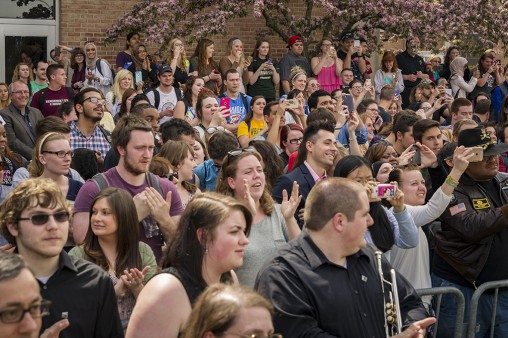
Nearly 2,000 students, faculty, staff and others turned out to witness the ribbon cutting for the Tom Hanks Center for Motion Pictures. (Photo by Chris Snyder)
2:55 p.m.
Hanks arrives for the dedication of the Center for Motion Pictures, saying he hopes it inspires students to do the hard work necessary to launch film careers. Nearly 2,000 students, faculty, staff and others turn out.
Hanks makes his entrance to a chorus of trumpet-playing students.
“I don’t think I can walk into any room ever again without that kickass fanfare.”
Although Hanks is not a graduate of Wright State, he performed in a Shakespeare production at Wright State in 1978 and has a long-running love affair with the university.
Hanks has started a scholarship fund at Wright State, produced videos in support of the university and given countless hours to help raise money for its performing arts program.
He is currently the national co-chair of Rise. Shine., the fundraising campaign that promises to further elevate Wright State’s prominence by expanding scholarships, attracting more top-flight faculty and supporting construction of state-of-the-art facilities.
At the dedication ceremony, Hanks jokingly warns students against defacing the building, whose striking blue color sets it apart from other campus structures.
“It’s nice to have the building. It’s nice to have the crisp editing rooms. It’s nice to have the brand new equipment. It’s nice to have all of the gear that goes along with it,” he said. “But that’s not the measure of a school’s greatness, and it’s not the measure of the quality of the student body that Wright State is going to produce.”
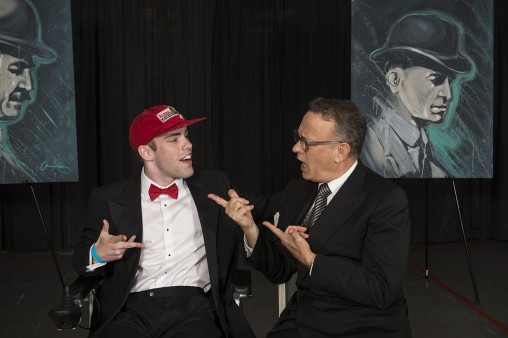
Motion pictures student William Crotty joking around with Tom Hanks at the gala celebrating the success of the Rise. Shine. Campaign. (Photo by Will Jones)
7:30 p.m.
A gala celebration at the Wright State Nutter Center to celebrate the success of the Rise. Shine. Campaign begins.
Hanks tells a story about how dozens of groupies waiting for him in the lobby of a Berlin hotel suddenly lost interest when actress Sophia Loren walked in. And he has a little fun with the blue color of the motion pictures center.
“Someone is going to say, ‘I will give you $10 million for my own building with my name on it provided you paint it to look like vanilla ice cream with rainbow sprinkles.”
Then he gets serious.
What you have at Wright State is a “life-altering force for good,” said Hanks.
“Wright State has already changed lives, and with $152 million — holy cow. Everybody who contributed to the Rise. Shine. Campaign has already changed lives for the good.”
The contributors have “done something great, not just for Wright State, not just for Dayton, Ohio, but something magnificent for the world,” said Hanks.
And then he was gone.

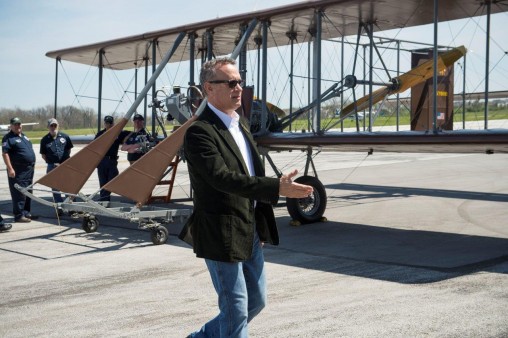
 Milling around
Milling around  Wright State recognizes Nursing Professor Kim Ringo for advancing international student success
Wright State recognizes Nursing Professor Kim Ringo for advancing international student success  Wright State honors graduating students for distinguished doctoral dissertations
Wright State honors graduating students for distinguished doctoral dissertations  Top 10 Newsroom videos of 2025
Top 10 Newsroom videos of 2025  Museum-quality replica of historic Hawthorn Hill donated to Wright State
Museum-quality replica of historic Hawthorn Hill donated to Wright State 